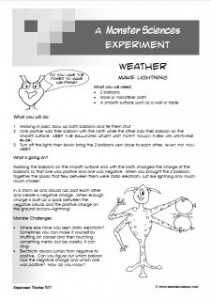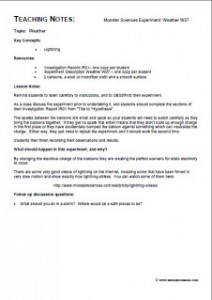Make your own lightning in this fantastic weather experiment!
 |
 |
An experiment about Weather: Make lightning
What you will need:
- 2 balloons
- Wool or microfiber cloth
- A smooth surface such as a wall or table
What you will do:
1 Working in pairs, blow up both balloons and tie them shut.
2 One partner rubs their balloon with the cloth while the other rubs their balloon on the smooth surface. Keep the balloons apart and don’t touch them on anything else!
3 Turn off the lights then slowly bring the 2 balloons very close to each other. What do you see?
What is going on?
Rubbing the balloons on the smooth surface and with the cloth changed the charge of the balloons so that one was positive and one was negative. When you brought the 2 balloons together the sparks that flew between them were static electricity, just like lightning only much, much smaller!
In a storm air and clouds rub past each other and create a negative charge. When enough charge is built up a spark between the negative clouds and the positive charge on the ground occurs—lightning!
Monster Challenges:
- Where else have you seen static electricity? Sometimes you can make it yourself by shuffling on carpet and then touching something metal, but be careful, it can sting!
- Electricity always jumps from negative to positive. Can you figure out which balloon had the negative charge and which one was positive? How do you know?
Teaching Notes: Monster Sciences Experiment: Weather W07
Topic:
Weather
Key Concepts:
Lightning
Resources:
- Investigation Record IR01– one copy per student
- Experiment Description Weather W07 – one copy per student
- 2 balloons, a wool or microfiber cloth and a smooth surface
Lesson Notes:
Remind students to listen carefully to instructions, and to OBSERVE their experiment.
As a class discuss the experiment prior to undertaking it, and students should complete the sections of their Investigation Report IR01 from ”Title to “Hypothesis”.
The sparks between the balloons are small and quick so your students will need to watch carefully as they bring the balloons together. If they get no spark that either means that they didn’t build up enough charge in the first place or they have accidentally bumped the balloon against something which can neutralize the charge. Either way, they just need to repeat the experiment and it should work the second time.
Students then finish recording their observations and results.
What should happen in this experiment, and why?
By changing the electrical charge of the balloons they are creating the perfect scenario for static electricity to occur.
There are some very good videos of lightning on the internet, including some that have been filmed in very slow motion and show exactly how lightning strikes. You can watch some of them here:
http://www.monstersciences.com/electricity/lightning-videos/
Follow up discussion questions:
- What should you do in a storm? Where would be a safe places to be?
Get this experiment here or as part of a bundle of Weather Experiments here.



